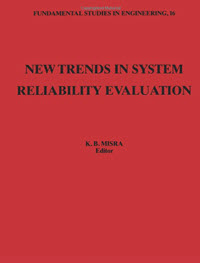Back to Books By Dr. Krishna B Misra
New Trends in Reliability Evaluation
ISBN-10: 0444565264
ISBN-13: 978-0444565266
Contents
Section I – Future Trends
| Part I : Reliability Engineering for the Future, 10-pages. | Gerard Collas (France) |
| Part II : New Trends in System Reliability Evaluation, 18-pages. | Krishna B. Misra (India) |
Section II – Towards Improved Techniques
| Multiple Variable Inversion Techniques, 35-pages | Malathi Veeraraghavan and Kishore Trivedi ( U.S.A.) |
| Part I : Decomposition and Reduction Techniques, 29-pages. | Frank Beichelt ( Germany) |
| Part II : Probabilistic Graph-Reduction Techniques, 36-pages. | Andrew M. Shooman (U.S.A.) |
| Parallel Algorithms and Implementations, 18-pages. | Narsingh Deo and Muralidhar Medidi (U.S.A.) |
Section III – Towards Improved Analysis
| Reliability of k-out-of n Systems, 36-pages. | Ali M. Rushdi (Saudi Arabia) |
| Consecutive k-out-of-n Systems, 15-pages. | S.G. Papastavridis and Markos V. Koutras (Greece) |
| Fault Tree Analysis , 62- pages. | Hiromitsu Kumamoto (Japan) |
Section IV – Towards Better Tools
| Digraph and Causal Trees, 24-pages | Takhisa Kohda and Koichi Inoue (Japan) |
| Use of Petri Nets for System Reliability Evaluation, 25-pages | Gurdeep S. Hura (Singapore) |
Section V – Towards Better Models
| Human Reliability Modeling, 40-pages. | Joseph Sharit (U.S.A.) |
| Common Cause and Dependent Failure Modeling, 30-pages. | Per Hokstad (Norway) |
| Software Reliability Modeling, 33-pages. | Tom Downs (Australia) |
| Mechanical System Reliability Evaluation, 23-pages. | S.S. Rao (U.S.A.) |
Section VI – Towards Alternative Approaches
| Use of Fuzzy Sets Theory (Part I : Theory), 45-pages. | Krishna B. Misra (India) |
| Use of Fuzzy Sets Theory (Part II : Applications), 33-pages. | Takehisa Onisawa (Japan) and Krishana B. Misra (India) |
| Dempster-Shafer Theory and its Applications, 37-pages. | Toshiyuki Inagaki (Japan) |
Section VII – Towards Development of Non-Specialist’s Aid
| Expert System in Reliability Evaluation, 27-pages. | D.J. Russomanno, R.D. Bonnel and J.B. Bowles, (U.S.A.) |
| Reliability Analyzer, 48-pages | Krishna B. Misra (India) |
Review & Comments
The subject of system reliability evaluation has been extensively and incisively discussed as in the present volume. The book fills a gap in the existing literature on the subject by highlighting the shortcomings of current state of the art and focussing on ongoing efforts in aimed at seeking better models, improved solutions and alternative approaches to the problem of system reliability evaluation. The book’s objective is to provide an insight into developments that are likely to revolutionize the art and science in the near future. At the same time it will help serve as a benchmark for the reader not only to understand and appreciate the newer developments but to profitably guide him in reorienting his efforts. This book will be valuable for people working in various industries, research organizations, particularly in electrical and electronics, defence, nuclear, chemical, space and communication systems. It will be useful for serious minded students, teachers and for the laboratories of education institutions. Dr. Misra, editor of the book, is a well established reliability engineer
….the book is written at a relatively advanced level and as such will appeal more to researchers and academics than everyday working reliability engineers. . Again, it would appear that the book has been prepared from different camera-ready materials as there is no uniformity in quality, style or standard of print in different chapters, which proves a little disconcerting to the reader. ..
Notwithstanding the above relatively minor criticisms, the book is a major work of scholarship and a copy should be acquired by every major academic and research library. In Europe copies can be purchased from Elsevier Amsterdam; North American readers can obtain copies from Science Publishing Co. Inc., New York


